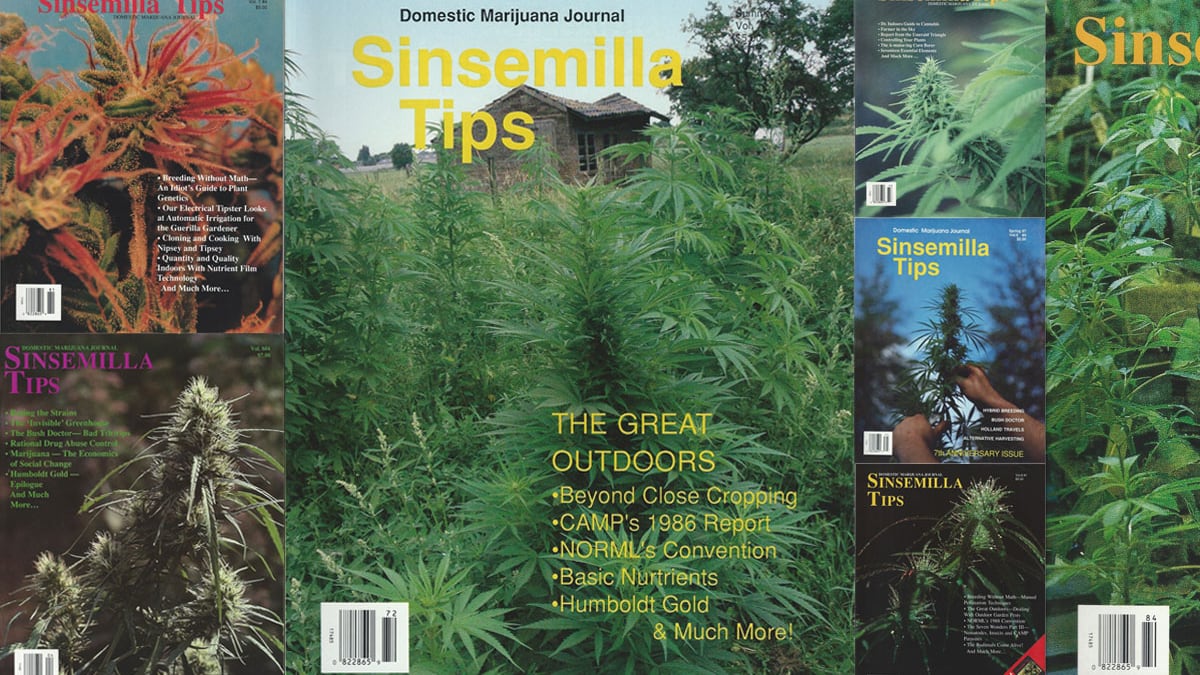Tom Alexander wanted to be a marijuana grower. Instead, he ended up a journalist.
As the founder of Sinsemilla Tips and The Growing Edge, Alexander is a legend in pot publishing. His magazines, based in Corvallis, were "the nation's only technical journal for the marijuana industry." Alexander helped hundreds of thousands of growers survive the ravages of spider mites and their closest mammalian relative, Nancy Reagan.
Related: What I Learned by Reading a Bunch of Vintage Drug Magazines
Alexander retired from his magazines in 2009 and now lives in Sacramento, where he has a CBD-focused farm, consults with upstart growers and runs Sinsemilla Tips as a Facebook group. He's gone from outdoor sinsemilla to hydroponic tomatoes and is now an advocate for natural outdoor-grown cannabis.
Alexander's story is, in many ways, the story of American marijuana since the mid-'70s.
And it starts with a clerical error.
Were it not for cops flubbing one of the numerals in the address of his grow outside Corvallis, Alexander was headed for prison. Instead, the tainted evidence cops stole from his humble 1,324-plant grow was discarded.
"Stole," is the appropriate word, because when the cops busted his mature crop, they didn't burn it in a bonfire. Rather, they set about selling it—as cops are wont to do with a drug haul so large they can't consume it themselves.
"They stole it and were selling it, and they got arrested by the Oregon State Police," Alexander says. "The Benton County district attorney, when they pleaded no contest, said they suffered enough and so he suggested to the judge that they get three years probation. Before the charges were dropped against me, I was facing 20 years and a $100,000 fine. So I got pissed off and started Sinsemilla Tips. Originally, I wanted to write a book, but all my grower friends said, 'No, no, we need an ongoing journal!'"

They embraced that journal. Early editions covered guano fertilizer, camouflaging greenhouses, and the intricacies of drip irrigation. He drove copies of the magazine down to Humboldt [Calif.] and up to Seattle.
"Growers started writing articles, and it took on a life of its own," he says. "I hired graphic designers and editors, and it became a real publication."
It was a good time to be in the grow supply business, as marijuana cultivation was newly equipment-intensive. During the Reagan years, cops used airplanes to bust outdoor grows. So growers moved indoors, using the hydroponic techniques we now know so well.
Then came a 1985 law that criminalized the possession of certain types of fertilizer, lights and other normal growing supplies if "intended for illegal use."
In 1989, the Drug Enforcement Administration cooked up Operation Green Merchant. President George H.W. Bush's goons raided retail stores in 46 states, arresting 119 people and seizing business records so they could hassle anyone doing business with the magazines or their advertisers. They even tried to obtain lists of magazine and catalog subscribers, according to The New York Times.
"Users are a major factor in the drug trafficking problem, and they are going to be held accountable and subject to suitable penalties, both civil and criminal,'' the DEA's Terrence W. Burke told the Times.
Pretty much everyone targeted was located through the pages of widely distributed magazines.
"They went after grow shops, mainly the ones that were advertising in High Times and Sinsemilla Tips, and basically it killed our revenue stream," he says. "But I had seen the handwriting on the wall about a year before, and I'd started another magazine."
That magazine was called The Growing Edge, which concentrated "entirely on new high-tech gardening information, with no mention of marijuana. However, the information can be applied to cultivating marijuana."
"I would go to the International Society of Horticultural Science conferences—which is the university researchers and all the big researchers around the world—which has a subcommittee on controlled environment agriculture and greenhouse growing," he says. "I would do stories on the conferences and the farms in the countries where I was at where they were using hydroponics and state-of-the-art greenhouses. So the pictures were all about tomatoes and cucumbers, but the information could be used for cannabis."
It worked—his subscriber list doubled.
Although he dedicated much of his career to hydroponics, Alexander has returned to his sun-grown, natural-soil roots—the kind of organic-style cannabis you'll find celebrated at WW's Cultivation Classic next month.
"Sun-grown, organic, in-soil is the way to go," Alexander says, "even though I was one of the ones to push indoor in the '80s with Sinsemilla Tips. It's going to be just like the organic food movement. There's going to be people who consume chemically grown, artificial light, mechanically trimmed, and there's going to be those who want top-shelf connoisseur-quality stuff, and that's natural, sun-grown organic."
WW's Cultivation Classic is at Revolution Hall, 1300 SE Stark St., on Friday, May 12. Noon-8:30 pm. $25. Visit wweek.com/cultivationclassic for a full schedule.

